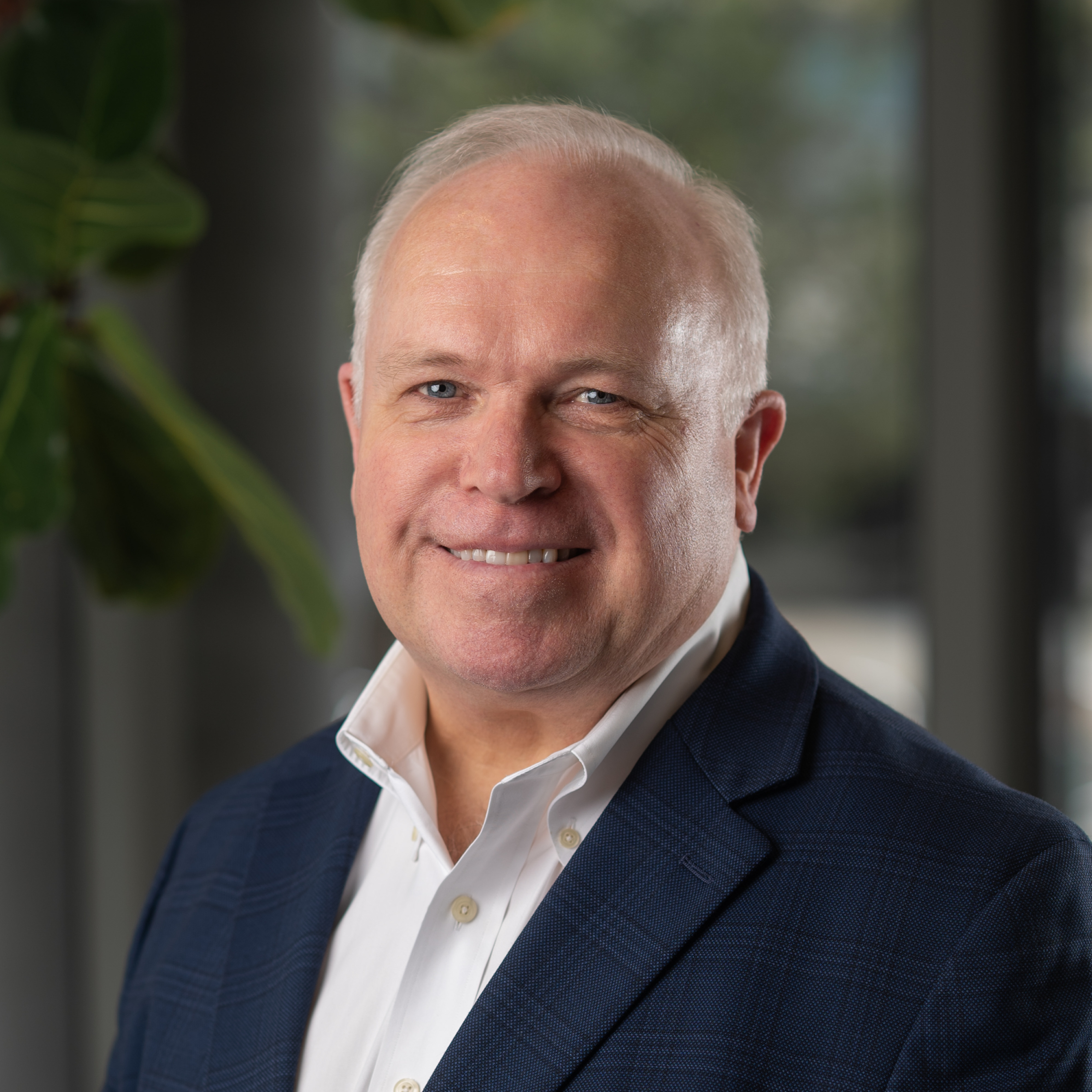All posts by Gary Stockton

The lease for the $50,000 office equipment seemed like any other order at first glance. The customer passed the credit check without issues. But when the multinational corporation was unable to collect payment, it dug deeper and realized that the ship-to address was a residence. With more research, the business discovered that its “customer” had used stolen identity information to pass the credit check. Because the company did not use systems to check for fraudulent ship-to addresses, the fraudulent order was unnoticed and the company fell victim to ship-to fraud. Although only a handful of the company’s customer accounts were fraudulent, the company lost a significant amount of money last year because each account included large six-figure deals. What is ship-to fraud? In a ship-to fraud scheme, a criminal poses as a customer and presents a verifiable billing record, address and credit history. Companies often deem these criminals as credit worthy because their records are up to date and they have a good credit history. Often, the first few orders placed are for smaller items and the bills are paid on time, which increases the criminal’s credit limit. The criminal then places a significantly larger item and never pays the bill. Because the shipping address is a location unrelated to the actual business, the criminal can easily pick up the order and sell the goods. While ship-to fraud happens with consumer goods, the impact is typically more significant in the B2B world because the cost of the goods is higher. Also, most consumer goods are paid for before the items ship. However, B2B companies often extend lines of credit to customers or bill at set intervals, which means products are often shipped before payment. Keys to reducing risk Here are five ways you can help prevent B2B ship-to fraud at your company: Review your business application process. Most companies ask for headquarter information when determining the creditworthiness of a new business customer. However, many companies have products shipped to locations other than the headquarters. During the application process, capture all operating locations on the application. This makes it easier to determine which shipments are going to legitimate addresses and those that may be potentially fraudulent. Compare ship-to addresses with all operating location addresses. If a product is being sent to a location that was not listed on the business application as an operating address, there is a risk the purchase is fraudulent. The risk is even higher if there is large physical distance between the ship-to address and the customer’s operating and billing locations. Determine if the ship-to address is a freight forwarder or consolidator. If the ship-to address includes a container number, it is possible that the purchase is fraudulent. Criminals often use freight forwarders and consolidators to receive fraudulent purchases because it creates more anonymity for the fraudster. Check to see if the ship-to address is a P.O. box. Because most businesses don’t use a P.O box for product orders, a P.O. box used as a ship-to address should be a red flag for potential fraud. P.O. boxes are another way criminals anonymously receive purchases. Look up the address on Google. Put the address into Google and see if the business placing the order shows up in the search results. If not, look for these red flags: - A residence – Consider if a home-based business is likely to order the product. - A forwarding or consolidating business – Some of these types of businesses do not use container numbers in the address, which means physical verification is your best protection. - Property for sale – While shipments to properties on the market can be legitimate, this raises concerns because criminals often use vacant buildings as ship-to addresses. View the location on Google Maps. By viewing the photos online, you can get further verification that the address is an actual business. You can often get a feel for the area and see if there are a lot of vacant buildings or other red flags. Be sure to check the data on the photo to see if it was taken relatively recently. Empower employees to escalate potential fraud. Your employees are your first line of defense against ship-to fraud. They are the ones processing the orders, printing the shipping labels and packing the boxes. Train your employees on potential red flags and have a process to handle concerns. Encourage employees to pick up the phone and speak with customers to clarify any concerns about the address. If they aren’t convinced it’s a legitimate order, have a process for the employee to stop the shipment and escalate the issue up the chain of command. Many legitimate businesses and shipments may have a single red flag for ship-to fraud. However, when an order has multiple red flags, you should be especially cautious and delay the shipment until the shipment is proven legitimate. Because manually confirming all ship-to addresses can be time consuming, many businesses are now using automated solutions to flag suspicious orders. Your B2B company can save money and time by using a system to help eliminate ship-to fraud. By waiting to develop a process to prevent this type of fraud, your company risks becoming the next cautionary tale.
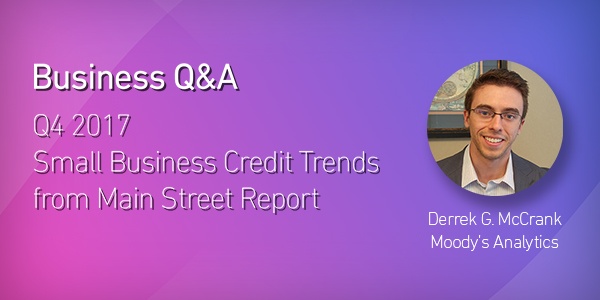
Gary Stockton: Experian has just released the Q4 2017 Main Street Report. We partner with Moody's Analytics on this report each quarter, and Derrek Grunfelder-McCrank is the economist who works on the report. We asked him a few questions about the trends that we're seeing in this quarter's data. Gary Stockton: The latest Main Street Report states that small business credit conditions remain positive. Is there a primary factor that's driving this stability? Derrek G. McCrank: Yeah there certainly is Gary. The primary factor that's driving stability in small business credit is the broader U.S. economy. Right now we have the labor market that's tight. This is resulting in wage increases for consumers as a result. Consumer spending has been reliable. Inflation is starting to pick up in a slow steady manner. On top of it all at the end of last year we just got tax reform. Right now the outlook for small business credit is positive. And that doesn't look set to change anytime soon. Gary Stockton: and are you seeing greater numbers of small businesses investing in that business by borrowing for equipment purchases? Derrek G. McCrank: Well Gary while we can't say for certain. The data seems to suggest that this isn't happening to the extent it could just yet. One of the questions in the NFIB's monthly survey is about whether firms are planning capital expenditures in the next three to six months. Since the end of the last recession. We've seen the positive response rate to this question steadily increasing. However it still sits below its long term average. Couple this with tax reform coming so late at the end of last year, and a decent number of firms are likely to have waited until the new year when they could invest in their business with a little more certainty. Gary Stockton: Well historically small businesses been keeping bankruptcy in check, but this quarter we saw it up slightly. Is this a major concern? Derrek G. McCrank: This isn't a cause for concern yet. Though it is something to monitor going forward. In the first quarter of 2017 the small business bankruptcy rate bottomed out, it hi its floor. As the year progressed, the bankruptcy rate moved off of that floor and that appears to be all that happened. In fact I'm hopeful that this might indicate a return to a more dynamic environment for small businesses which I look forward to discussing in a little more detail and our upcoming webinar. But for now, given the state of the economy, I'm optimistic for the state of small business credit. Gary Stockton: On the flip side, the Northeast saw a steep decline in business bankruptcies in Q4. Can you share some insight on what might be driving that? Derrek G. McCrank: Sure, so in the fourth quarter. the Northeast saw declines in its severely delinquent or 90 days past due rate coupled with a slight uptick in its business bankruptcy rate. What happened with business bankruptcies mirrored the trend nationally, so it shouldn't be a cause for concern this year, the declines in the severely delinquent rate were driven by two primary factors - geography and industry, from a geographic point of view, Connecticut, New Hampshire and Maine were the driving forces behind the reductions in severe delinquency, and from an industrial point of view financial services, public administration and the manufacturing industries are credited with declines in severe delinquency. Download the latest report

So you’ve created the perfect campaign with great creatives and an unbeatable offer. You deploy the campaign and sit on the edge of your seat waiting for all the leads to flood in. After a couple of days, you notice a couple of responses but nowhere near the volume of what you were hoping for, and you’re stuck asking yourself “why?” Here are a couple of hypotheses: 1.) the people you reached out to aren’t the right audience so they don’t care about your offer, or 2.) your target audience didn’t see your efforts because you used the wrong channel. The process of finding new business customers can be expensive and sometimes unpredictable, but it doesn’t have to be. Here are 3 tips to help improve your prospecting efforts: Tip #1: Define your ideal customer One of the most fundamental ways you can help grow your current customer base is to have a clear understanding of what they actually look like (or defining what they should look like). What’s their job title? What are their biggest business challenges? Are they web savvy? How do they prefer to get industry news? Addressing discovery questions like these allows you to better understand who you’re talking to and how to talk to them. Additionally, you’ll be able to use this profile to help you mimic your best customers and target look-a-likes. Tip #2: Target new businesses Get your products/services in front of new businesses before your competitors. Not surprisingly, many marketers overlook targeting new businesses because of the lack of data -- how do you know a new company is in business? How do you know if they’re the right business for you to even target? Fortunately, there are many services in today's market that can help fill in the gaps. Using something like Experian’s US Business Database, which is a database of more than 16 million active U.S. companies, can help you discover new businesses sooner and beat out your competitors to reach them first. Tip #3: Find the decision-makers Identifying the right businesses to target is important, but ensuring that your offer gets in front of the right person – the decision maker – is even better. By finding the decision maker and directing your marketing efforts towards them, you can rest assure that your message lands in the hands of the person that matters most. Want to take it one step further? Once you know who you’re talking to, you can tailor the message and offer to be more relevant for that specific audience, which ultimately helps increase your chances of getting a response. Finding and reaching new business customers can be a daunting and expensive tasks, especially if you don’t target your prospecting efforts. Be sure to keep these tips in mind when approaching your marketing strategy and don’t let today’s data challenges hold you back. Learn more about Experian's US Business Database or our other marketing capabilities.
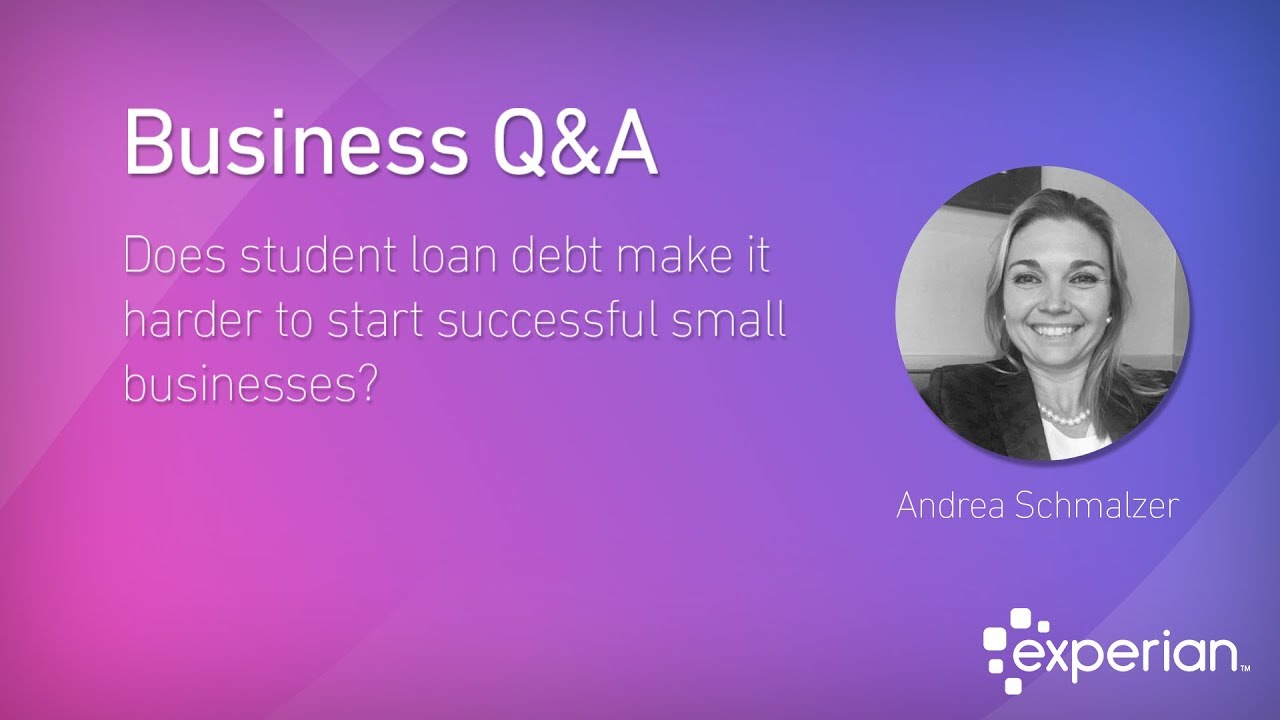
According to the Kauffman Foundation business starts in the United States have been on a steady decline for the past four decades, while the cost of education has risen. In fact, as of 2017, outstanding college debt stood at 1.4 trillion dollars. So how does student debt impact business owners who started a business after college? In our latest Business Q&A I ask Andrea Schmalzer about her recent study of business owner student debt. Gary: Andrea why did you to decide to study student debt for small business owners? Andrea: Hi Gary we decided to take a look at student loan debt in regard to small businesses due to the fact that student loan debt has now increased to over one point four trillion dollars. In addition to that, small business creation has been on a downward trend basically since the 1990's. So we decided to take a look and see if student loan debt was impacting new business creation and longevity. Gary: And are there any industries where student debt has seen a significant increase? Andrea: Yes. In the public administration segment, which includes prisons, research laboratories, realtors, state run businesses, we saw an increase of student debt of about 89 percent between the years 2012 and 2017. So right now small business owners are opening their businesses with close to 60 thousand dollars in debt, when back in 2012 it was just over 30 thousand. Gary: And were there any other interesting insights that you saw in the data? Andrea: Actually yes. The biggest finding that we had was that having student loan debt didn't impact business survival. We have in our sample almost 79 percent of small businesses with student loan debt lasting five or more years. And that's compared to about 60 percent survival rate of five or more years for small businesses as a whole. So we're seeing a definite positive trend with small business owners acquiring student debt. To learn more about these insights, download the whitepaper. Download Whitepaper Help us spread the word! Click To Tweet!
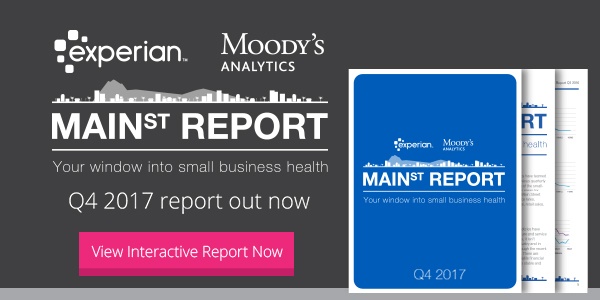
Experian and Moody’s Analytics just released the latest Experian/Moody’s Analytics Main Street Report for Q4 2017. The report brings deep insight into the overall financial well-being of the small-business landscape, as well as providing commentary around what certain trends mean for credit grantors and the small-business community. The overall outlook for small-business credit is positive. Outstanding balances rose in the fourth quarter, as did the average balance outstanding per business. Delinquency and default rates rose slightly, suggesting that credit conditions have loosened. Continuing strength in the macroeconomy will keep small businesses moving in the near term, along with higher profits from the recently passed tax legislation. Small-business credit will be less certain in the medium to long term as rising wages and tax code changes take a toll. Northeast sees the steepest decline in delinquency The Northeast saw the steepest decline in severe delinquencies in the fourth quarter, and construction was one of the industries responsible for that trend. Many small construction firms have a focus on residential projects, making consumer credit growth an ideal metric to use as a basis for understanding what’s happening and what will happen in the industry. We have published the entire contents of the report in an interactive page, complete with charts and graphs. Download Main Street Report
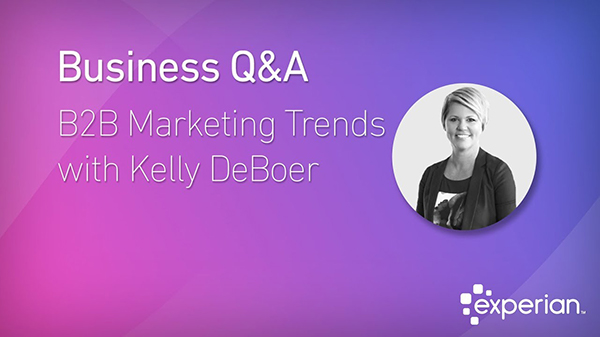
I had the pleasure of speaking with Kelly DeBoer recently. She is a Product Manager at Experian working in Business Information Services. Kelly leads product strategy for our business marketing products. In this Business Q&A we talk about B2B marketing trends and how Experian is helping business clients get the most out of their marketing initiatives. Gary: B2B marketing has changed significantly in the last five years. What are some of the important trends that you're seeing? Kelly: What we're seeing in the B2B space is really what we've seen in the B2C space for years, and that is, our clients are really trying to gain as much insight into their not only existing clients but potential clients as well? So you know additional firmographic information, credit information, anything that gives them a fuller picture of their clients, and then not only how to retain their existing clients and cross-sell, but also in terms of prospecting, how to best reach these targets once we've identified them what's the best channels to reach those prospects to get the best response. Gary: Kelly, most of our clients think of Experian Business Information Services as firstly business data and credit risk management. So how are we helping clients with their marketing initiatives? Kelly: With regard to B2B marketing, Experian has a tremendous amount of marketing assets including not only our U.S. Business Database which has over 16 million businesses. We also overlay that with our credit information, so clients can come and tap into this this huge resource to help them with their targeting in terms of selecting by firmographics, employee size, sales volume, as well as credit attributes, UCC filings, bankruptcies, information that can be translated to marketing campaigns. It can be utilized for direct marketing, for telemarketing, for digital applications - social media, email campaigns, analytical solutions, modeling. So it's a vast amount of resources that we can tap into to help with marketing campaigns. Gary: Can you share about some B2B marketing solutions we can look forward to from Experian? Kelly: Experian has a lot on the horizon with regard to B2B marketing. But one thing I'm particularly excited about is our new B2C linkage business to consumer linkage. Ultimately our clients have been coming to us saying you know, we're looking for a way to link our consumer records to any businesses that they may be associated with. So we create a customized linkage system that allows us to take in those consumer records, match them to our commercial repositories, and then provide back information that allows our clients to then not only target that consumer at their residential address but also their business address. So it gives them a chance to cross-sell and up-sell commercial offers as well as their consumer offers. Experian Business Marketing Solutions
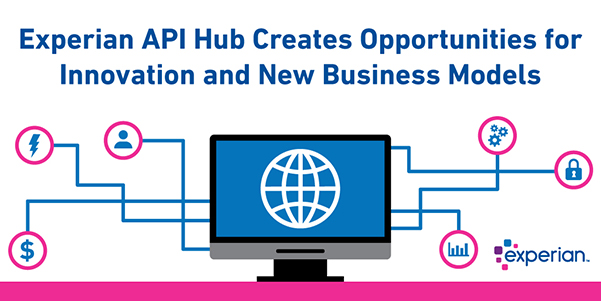
Carl Stronach is the Senior Product Manager for Experian’s API Developer Hub. We sat down with him recently to discuss how API’s are helping business clients solve problems, and to get answers to some frequently asked questions about Experian Business API’s, how they work, and how developers can get started using them. What is the API Developer Hub and Why Did Experian Launch It? The Experian API Hub is a one stop shop for all Experian data. Whether client developer’s come into Experian to access our information on businesses, consumers, automotive data, data quality, they can find all our API’s in one place through one developer account. It makes it much easier for developers to come in find all the data assets that Experian has and start testing that data in just minutes. So clients are coming into the API hub and they’re coding to our API’s to integrate that data into their applications. And so one of the most exciting things that I find is when clients will share a screenshot with me of all our data that’s live in their application. Can you give us some examples of the kinds of apps clients have connected to the hub, do we know what data is being used for? We see clients using the API is for a variety of reasons. The first one would be your traditional credit underwriting. They need to have a Credit Manager access Experian data within their own application so that they can make a credit decision. The API makes it easy to put all the data that a Credit Manager needs on one single screen. That’s what they are designed to do. And so that’s probably the first use case. The second use case that clients are coming into is when they’re running their own platform. Clients are coming in. They might be a fintech company. They might be a special niche provider of business information on a specific industry. So the API’s enable not only Experian to have a direct relationship with clients and end users, but also enable our own partners to give their end users access to Experian data within their applications as well. Does the Experian API Developer Hub open up opportunities for new business models? We’re enabling new types of clients to come into Experian and start working with our data, clients who would have never done that before. We’re opening the market to these types of developers to create new types of innovations. It spurs innovation. So yes, we think the API Hub enables new business models to be created. One of the ways we’re tackling that is by making the API’s available for startups making the API’s available for startup incubators. There’s all these little networks of startup incubators that allow all their startups to get access to different data assets, or different API’s to solve these business problems. Experian is getting into those incubators to allow our data to be at the fingertips of these startup environments where we can go a step further than just the public developer portal access that we provide to everyone. For some of these businesses that are in these incubators, we can provide production grade data to businesses who are just starting up. Normally they wouldn’t have the capital or funds to access our data in the production environment if they were to come to us directly, but as a part of these programs they can get started in creating a real application at a relatively low cost in those early phases of their business. What are the key benefits of using an API over other processes such as batch delivery? Many clients today might be using a batch process to automatically update their portfolio. There are certainly many benefits to using a batch process. It’s a bulk process. We offer very competitive pricing when we’re talking about batch delivery. The disadvantage is that the data isn’t real-time. Underwriting decisions are best supported by access to fresh data. That’s real-time, and that’s exactly what the APIs do. So when a client makes an API call to us we calculate data based on the data we have available at that time. We’ll pull data to create calculate a score on the fly, a fresh score. Every API that we have delivers data that we have in our database in real-time, so that real-time data that you can get at your fingertips when a client is completing an application, and you can use that data in real-time to make real-time decisions. So there are a few different ways. Where can people learn more about Experian API’s? The best way to find out about our API is to go directly to our API developer portal. The API developer portal is at developer.experian.com. If you visit, you’re able to go to the portal see the API’s that we have, read our API documentation. You can register for an account in just a few minutes and start making test API calls to start seeing how you might interact with Experian data and integrate that into your application. Other ways that we’re supporting clients interacting with our API’s – we are focused on not only say Credit Managers, and those traditional use cases that we’re working with, but we’re really focused on the client developer, and so we’re trying to make it as easy as possible for developers to code to our API’s. We’re doing things like creating libraries. We have some developer libraries that are out on GitHub right now. There’s a Node.JS library and a Java library that is available. We also can provide what’s called a Postman collection to our developers. Basically, it lets them download our API’s onto their computer and start making test API calls to any of our API’s in just a few minutes. It makes it super easy to start coding and interacting with our API’s. We’re trying to provide these open source ways for developers to start working with Experian data. And you know we’re looking for that client feedback. You know, what types of developer libraries can we create to make it easier for you to code to our API’s and integrate. We want to make API integration as easy as possible for some clients, so we’re going the extra mile to create open-source code that makes it really easy to interact with Experian API. Experian API Developer Portal

Andrea Schmalzer is an analytical consultant in the Commercial Data Sciences team here at Experian, and she just completed a study of the mining industry titled "Managing volatility: the unique credit risks of the mining industry", so we did a quick Q&A with Andrea about her research. Gary: Hi Andrea, why did Experian study the mining industry? Have there been any notable changes to this industry in recent years? Andrea: Hi Gary. We decided to study the mining industry in order to evaluate the impact the mining industry has on small businesses that are supporting that industry. Knowing that there will be some volatility as we see shifts in which fossil fuels are predominantly being used. As far as changes go, we have seen a decrease in coal production. Some of this is due to the fact that we had the big boom in natural gas which caused the natural gas prices to decrease substantially. And also just due to the fact that the coal supplies are decreasing overall. Gary: Can you tell us what states driving the bulk of the mining in the United States. Andrea Schmalzer: So Texas is the number one oil and gas producers in the country. As far as natural gas we also had that being mainly produced in Pennsylvania and Oklahoma. For oil, we do see that being produced in North Dakota and California, and as far as coal mining goes that comes from Wyoming, Kentucky and West Virginia. Gary: Andrea what impact has the decrease in natural gas and oil production had on the local small business economy? Andrea: So, North Dakota was one of the most impacted states when the prices of oil dropped because they decided to stop drilling because it wasn't cost effective. So we did see employment drop quite a bit in the oil and gas industry. But overall as a state North Dakota is still under a 3 percent unemployment rate. Some of those folks are now working in retail or grocery stores, gas stations in hopes that new drilling will come up again. For businesses though we do see delinquencies shrinking in the retail segment also in the manufacturing segment. However we do see charge off's increasing for both retail and manufacturing which is one area we need to keep an eye on. Gary: With the falling supply of coal in West Virginia what trends are you seeing in business credit and delinquency? Andrea: Like you said we've seen a large decrease in coal production in West Virginia, most notably in the southern counties of West Virginia. And with that we've seen an increase in unemployment and in some cases an increase in delinquencies. For example the retail and service industries have seen an uptick in delinquencies in southern West Virginia compared to the rest of the state. But we aren't seeing write off's come through yet. So an area to keep an eye on. Also overall in West Virginia we do see higher delinquency rates in the agricultural industry for the coal counties versus non-coal counties. But again, like retail and service we aren't seeing the write the off's come through yet. So definitely an area we need to keep an eye on. Download Whitepaper
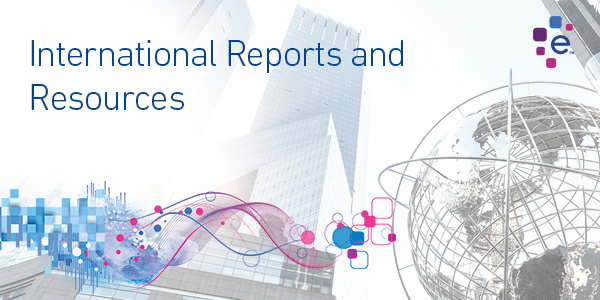
Here at Experian, we work with many clients whose customers and suppliers operate all over the world, and one of the biggest challenges for many is being able to detect financial duress by monitoring companies whose headquarters are outside of the United States. Early identification of negative activity helps your company prevent lost revenue and service interruptions, it also helps minimize reputational damage caused by doing business with a company in violation of U.S. laws. These early notifications can also help mitigate the effects of changing economic conditions while growing new business opportunities with lower risk. Today we are thrilled to announce that Experian’s commercial alerts now enable you to monitor more businesses in more countries with greater precision. Experian now offers 25 alerts on 8 countries in Western Europe, with 8 more countries coming soon! These international alerts offer the ability to stay up to date on changes such as: change in ownership, business name and address, as well as changes in credit limit, balance sheet information, and company status and much more. Proactive notifications empower you to act quickly and mitigate risk, collect on overdue amounts and retain your best customers. Want to know more? Contact us today so we can start helping you reduce the risk in your growing business. International Reports & Resources
